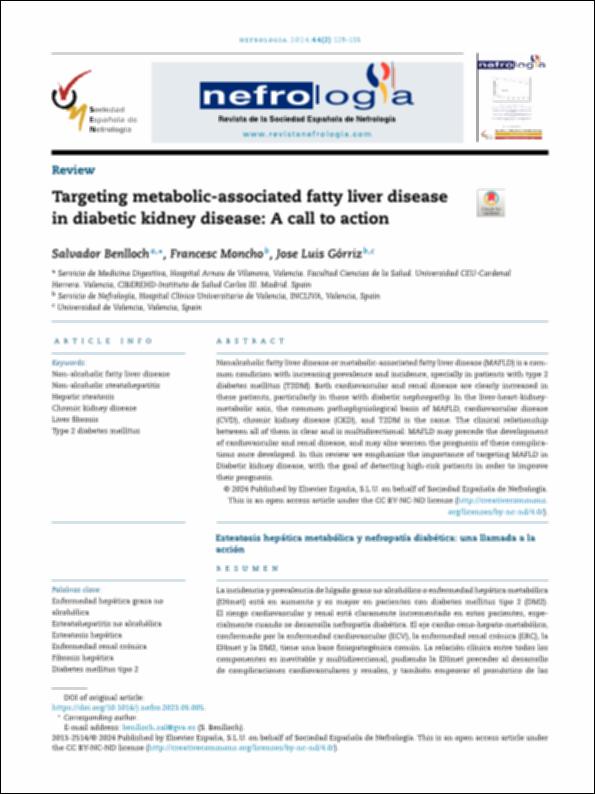Por favor, use este identificador para citar o enlazar este ítem:
http://hdl.handle.net/10637/16036Targeting metabolic-associated fatty liver disease in diabetic kidney disease: a call to action

Ver/Abrir:
Targeting_Benlloch_NEFROLOGIA_2024.pdf
1,29 MB
Adobe PDF
Ver/Abrir:
Esteatosis_Benlloch_NEFROLOGIA_2024.pdf
1,31 MB
Adobe PDF
| Título : | Targeting metabolic-associated fatty liver disease in diabetic kidney disease: a call to action |
| Otros títulos: | Esteatosis hepática metabólica y nefropatía diabética: una llamada a la acción |
| Autor : | Benlloch Pérez, Salvador Moncho, Francesc Górriz, José Luis |
| Materias: | Diabetes; Kidneys-Diseases; Riñones-Enfermedades; Liver-Diseases; Hígado-Enfermedades; Preventive medicine; Medicina preventiva |
| Editorial : | Elsevier España Sociedad Española de Nefrología |
| Citación : | Benlloch, S., Moncho, F. & Górriz, J.L. (2024). Targeting metabolic-associated fatty liver disease in diabetic kidney disease: a call to action. Nefrologia : revista de la Sociedad Española de Nefrología, vol. 44, i. 2 (mar.-apr.), pp. 129–138. DOI: https://doi.org/10.1016/j.nefroe.2024.03.009 |
| Resumen : | Nonalcoholic fatty liver disease or metabolic-associated fatty liver disease (MAFLD) is a common
condicion with increasing prevalence and incidence, specially in patients with type 2
diabetes mellitus (T2DM). Both cardiovascular and renal disease are clearly increased in
these patients, particularly in those with diabetic nephropathy. In the liver-heart-kidneymetabolic
axis, the common pathophysiological basis of MAFLD, cardiovascular disease
(CVD), chronic kidney disease (CKD), and T2DM is the same. The clinical relationship
between all of them is clear and is multidirectional: MAFLD may precede the development
of cardiovascular and renal disease, and may also worsen the prognosis of these complications
once developed. In this review we emphasize the importance of targeting MAFLD in
Diabetic kidney disease, with the goal of detecting high-risk patients in order to improve
their prognosis. La incidencia y prevalencia de hígado graso no alcohólico o enfermedad hepática metabólica (EHmet) está en aumento y es mayor en pacientes con diabetes mellitus tipo 2 (DM2). El riesgo cardiovascular y renal está claramente incrementado en estos pacientes, especialmente cuando se desarrolla nefropatía diabética. El eje cardio-reno-hepato-metabólico, conformado por la enfermedad cardiovascular (ECV), la enfermedad renal crónica (ERC), la EHmet y la DM2, tiene una base fisiopatogénica común. La relación clínica entre todos los componentes es inevitable y multidireccional, pudiendo la EHmet preceder al desarrollo de complicaciones cardiovasculares y renales, y también empeorar el pronóstico de las mismas una vez desarrolladas. En esta revisión enfatizamos la importancia de buscar y tratar la EHmet en pacientes con ERC de la DM2 con el objetivo de identificar pacientes de mayor riesgo y de mejorar su pronóstico. |
| URI : | http://hdl.handle.net/10637/16036 |
| Derechos: | http://creativecommons.org/licenses/by-nc-nd/4.0/deed.es |
| ISSN : | 0211-6995 1989-2284 (Electrónico) |
| Fecha de publicación : | mar-2024 |
| Centro : | Universidad Cardenal Herrera-CEU |
| Aparece en las colecciones: | Dpto. Medicina y Cirugía |
Los ítems de DSpace están protegidos por copyright, con todos los derechos reservados, a menos que se indique lo contrario.

